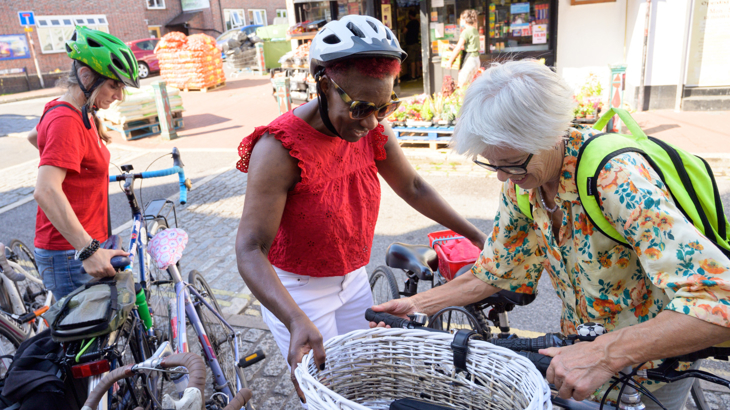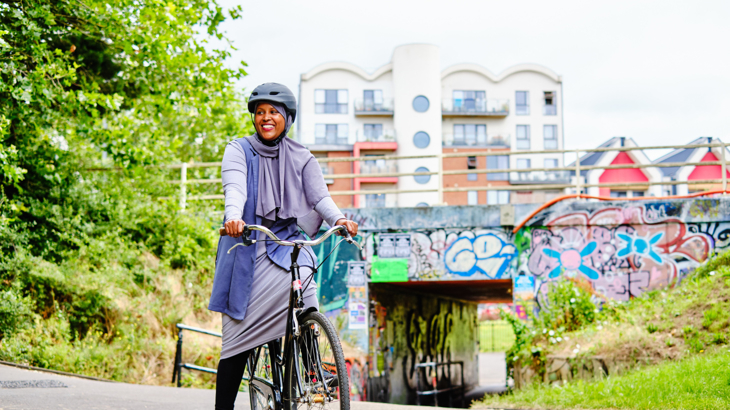In this blog, Tiffany Lam, Strategy Lead for Equity, Diversity and Inclusion at Sustrans, talks about our new Framework which highlights the ways Sustrans will address inequities within active travel. With safety and wellbeing, accessibility and economic inclusion in mind, we know there is still a long way to go when it comes to equality. We want to make active travel more equitable, diverse and inclusive.

Safety is more than safety from traffic. Our identities shape how we are perceived in, as well as how we perceive and experience public spaces. Credit: Jon Bewley
Embedding equity, diversity and inclusion into how we work
We're delighted to share our new For Everyone Strategic Framework, which sets out how we will address inequities within active travel.
The Framework has an internal dimension, which details our approach to embedding equity, diversity and inclusion in our internal structures and processes.
The external dimension provides us three areas of focus, so that we can adopt an intersectional gender perspective in our external delivery and campaigns work.
Our areas of focus
- Safety and Wellbeing.
- Accessibility.
- Economic inclusion.
Safety and wellbeing
Safety is more than safety from traffic.
Our identities shape how we are perceived in, as well as how we perceive and experience public spaces.
This contributes to how safe we feel when we are out and about.
For example, gender-based harassment and violence in public space is a barrier to safe mobility for women, girls and LGBTQ+ people.
We do not have the sole responsibility or power to address wider sexism and other systems of inequities.
But we will use our voice and work in partnership with others to amplify and address these issues, so that everyone can feel safe walking, wheeling and cycling.
We are developing a gender safety audit that we will consistently apply to projects, so that we can capture and respond to women’s, girls’ and gender diverse people’s differential perceptions and experiences of safety.
Accessibility
We will continue to build on our good work on improving walking, wheeling and cycling accessibility.
This includes continuing to promote the recommendations in our Disabled Citizens’ Inquiry, to help decisionmakers centre the perspectives and experiences of disabled people in policy, investment and practice.
For example, one of our policy asks is for a dedicated pavement fund to improve pavement quality and accessibility.
We have been – and will continue to – audit, improve and/or remove barriers on the National Cycle Network.
But we will also do more to address non-physical barriers to accessibility.
We are developing an accessibility audit that will help us make walking, wheeling[1] and cycling routes more accessible and inclusive.

We are developing a gender safety audit that we will consistently apply to projects, so that we can capture and respond to women’s, girls’ and gender diverse people’s differential perceptions and experiences of safety. Credit: Jon Bewley
Economic inclusion
Our work on economic inclusion will build on our Cost of Living paper, which highlights the economic benefits of walking, wheeling and cycling.
More than that, we are working to make active travel to be more accessible and viable for people with low or no incomes.
We are working to ensure that active travel routes consider and provide for journey purposes that tend to get overlooked in transport planning (e.g. care-related journeys).
Although transport policy and planning has historically reinforced and exacerbated economic, gender and racial inequalities, embedding intersectionality and equity can ‘help level the playing field. It can transform economies, connect people to opportunity, and empower underserved communities to build generational wealth for the future.’
And so, we will amplify our policy ask for fair financing for active travel.
We will also use our influence and voice so that active travel becomes more integrated into local, regional and national approaches to wider economic issues.
Looking forwards
We want to make active travel more equitable, diverse and inclusive. And our For Everyone Strategic Framework gives us a roadmap to do that more robustly and effectively.
[1] We recognise that some people who use wheeled mobility aids, for example a wheelchair or a mobility scooter, may not identify with the term walking and may prefer to use the term wheeling. We use the terms walking and wheeling together to ensure we are as inclusive as possible.





